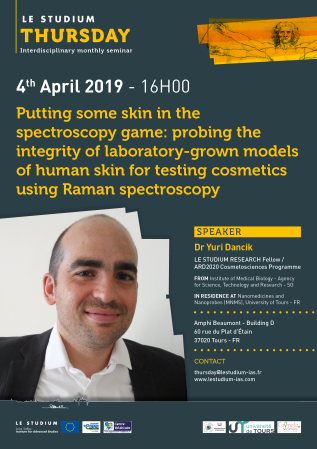Putting some skin in the spectroscopy game : probing the integrity of laboratory-grown models of human skin for testing cosmetics using Raman spectroscopy
Amphi Beaumont - Building D
60 rue du Plat d’Étain
37020 Tours
France
Presentation
European Union legislation bans the use of animals for the testing of cosmetic ingredients as well as the commercialization of cosmetics tested on animals. Similar legislation has either been implemented or is under consideration in a number of other countries. Cosmetic companies must thus rely on alternative, non-animal based methodologies to demonstrate the safety of their products. Laboratory-grown skin, a.k.a reconstructed human skin or epidermis, is an increasingly popular biological tool within cosmetic and pharmaceutical R&D enabling the testing of topical products without relying on animal skin. However, these human skin models must be characterized to determine their usefulness. In particular, it is important to assess their barrier function, that is, their ability to mimic our natural skin’s function of protecting our body from external insults.
Raman spectroscopy is a biophotonic technique increasingly used in skin science; its main advantages being that it is non-destructive, label-free and highly sensitive. In the cosmetic and pharmaceutical sciences, Raman spectroscopic methodologies are in development to study skin hydration, the effects of anti-aging formulations, and to track the penetration of compounds in skin. These studies mostly involve volunteers or the use of excised human or animal skin. Little work has focused on probing the barrier integrity of reconstructed human skin models using Raman spectroscopy. In our project, we use Raman spectroscopy to quantitatively characterize and differentiate the effect of different storage conditions on the barrier function of a reconstructed human epidermis model. We compare our spectroscopic results with those from conventional skin penetration experiments, with the goal of demonstrating the complementarity of both approaches.
The project aims to answer practical questions on the possibility of storing reconstructed human skin prior to use in cosmetic studies and to establish Raman spectroscopy as a reliable non-destructive methodology for probing the integrity of such skin models.
Speaker
LE STUDIUM Research Fellow / ARD 2020 - COSMETOSCIENCES Programme
FROM: Institute of Medical Biology - Agency for Science, Technology and Research - SG
IN RESIDENCE AT: Nanomedicines and Nanoprobes (MNMS), University of Tours - FR






